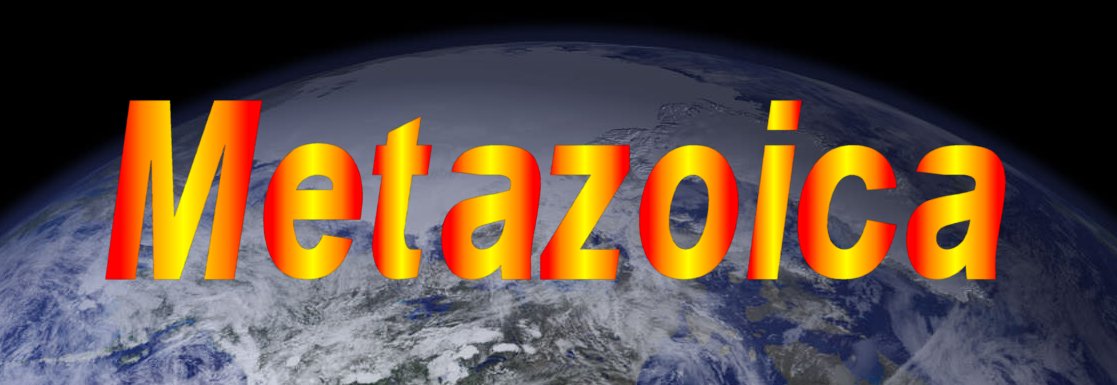Welcome to my Metazoic site! This site discusses the existence of the creatures to come along after humans will be extinct. I first became interested in a world after man when I acquired my first copy of Dougal Dixon's After Man: A Zoology of the Future in 1992. However, I unwittingly created creatures that did not exist from the time I was about 8 years old. But it was after I obtained a copy of that book (now a collector's item) that I decided to take these same creatures I created as a child and make them more realistic in an evolutionary sense. Though it may be hard for a lot of us to grasp, humans will soon become extinct. One of the biggest factors of how this will happen is the current overpopulation rate. Which is why I don't contribute to the population. I created this world with little more than mammals fulfilling all ecological niches with the help of some friends. I even gave the era of the age after man a name, I called it the Metazoic, derived from the words for "After-era" (Meta, meaning after, and zoic meaning era). We are now in the Cenozoic era. To view all the animals I have created since I began this project, you can go to the "Meet the Mammals" section of this site. To discuss your own ideas about what you think will happen in the future world, and share your ideas with others, please feel free to leave a comment.
One more thing, some of you may find this site quite offensive, and you have a right to your own opinion. But please respect my right to have an opinion too. I'm not saying there is no GOD, I believe it was HIM who got the ball rolling. But I believe after that, evolution took over. There is so much more evidence of evolution than there is of creation. Even that going on right under our noses. Other than that, enjoy yourself and visit our many links.
Sunday, October 5, 2008
My Simple Classifications
The large grazers (grazers over 5 feet long)
The predators (mammals that are for the most part, carnivorous).
The small grazers (grazers 5 feet long or less)
The pentadactyls (what we today know as 'primates')
The flying mammals (mammals that mostly fly or glide).
This simplifies everything because each group can contain several different orders. Though some are varying degrees of each group. For example, the armadillos of the Metazoic are all opportunists, they feed on anything. Yet I put them in the large grazers group. Most of them are less than 5-feet long too. I mix everything up according to how many species of each family represents each group. For instance, I place the true rat and mouse family (Pseudomyidae) in the small grazer group. Yet it is a highly varied family. There are some species in the family that are much more than 5-feet long, and there are also some that are carnivorous. But the majority of the family are of the small grazer type, so that is why I place them in this group. Key word being "majority".
The carnivores of the Metazoic are among the most interesting from my POV! If the predators (of any age) were to be measured like we measure the force of tornados, it would be interesting. For example, Deinognathus would measure out as an F5. They feed on any animal, moving or not, and have no predators, except other Deinognathus. The only examples of an F5 predator today would be orcas and great white sharks. Lions of today would be an F4, they feed on anything, but they do have some predators. Wolves of today would be an F3, they feed on anything, but have also been known to get themselves clobbered by some predators, more than lions would. This is the way I see classifying tomorrow's predators (using the same scale to measure storms with). The highest (F5) would be those who eat any creature they can find, and have no enemies or contemporaries in their range. The lowest (F1) are the small predators with limited abilities, like those only capable of bringing down prey smaller than themselves, and have lots of predators that hunt them. Much like the raccoons.
F1- raccoons, shrews, Harundopeds, small carnivorous rats.
F2- Parasitic shrews, small felines.
F3- bear-dogs, predatory squirrels, larger predatory rats, Bromista, Tyrannopithecus and other carnivorous lemurs.
F4- Phobocebus, large viverrids, smaller-to-medium-sized Deinognathids like Tamanoa, larger foxes like Velocitherium.
F5- Deinognathus, Ictocamelus, Daspletarctos, Spathodon, Galiditherium, Monarchomys, Smilomys, Eufoedes, Columpiphonium, Cercomoloch, Pterdraco, Carnophalanger.
There are also some top-knotch scavengers. They are in the families Ruonidae, Zouphionidae, and Cloacariidae. In these families, most (if not all) the species are scavengers who pick up after the predators. Particularly the kills of those predators in the F4/F5 category. But anyway, that's just pretend, not scientific. However if you ask me, it should be applied to animals of today and tomorrow.
Anyway, there is also a new group listed, based on the family I discussed for last week, the ant-hogs. They can be viewed at this link: http://www.metazoica.com/Hogs.html.

2 comments:
In your categorization of predators, where do the barofelids go?
I would say an F4.
Post a Comment